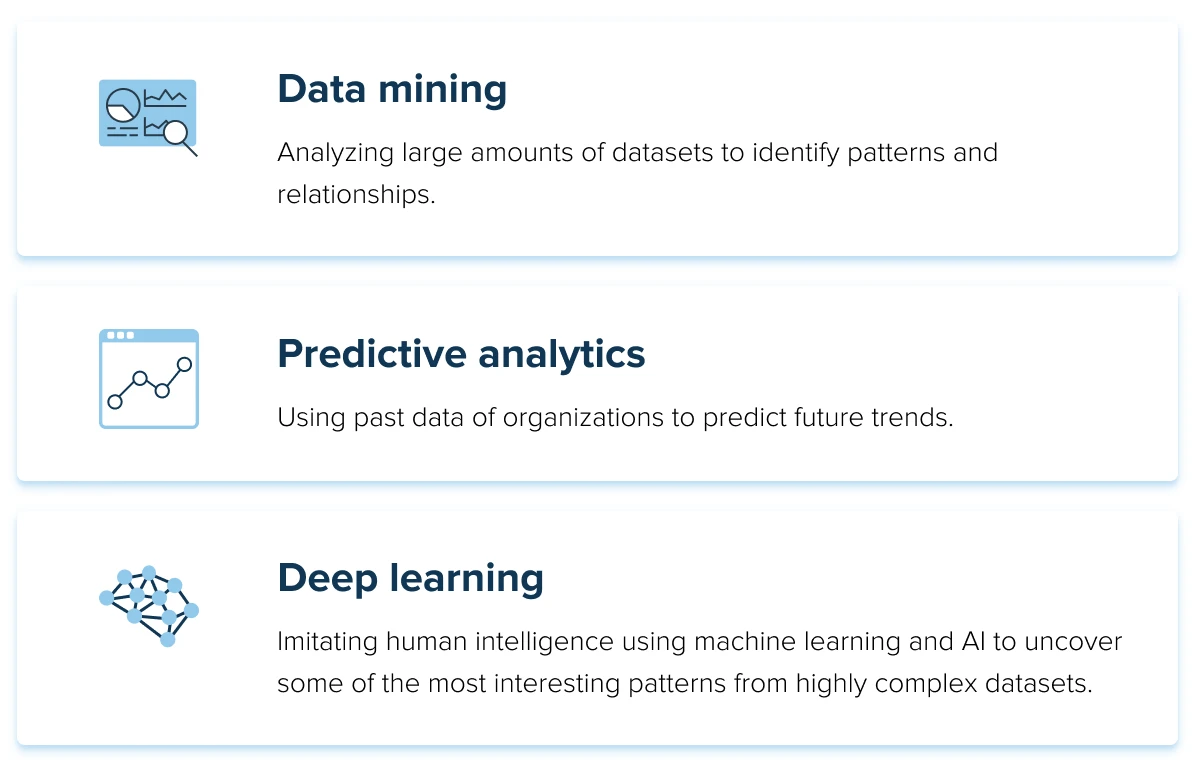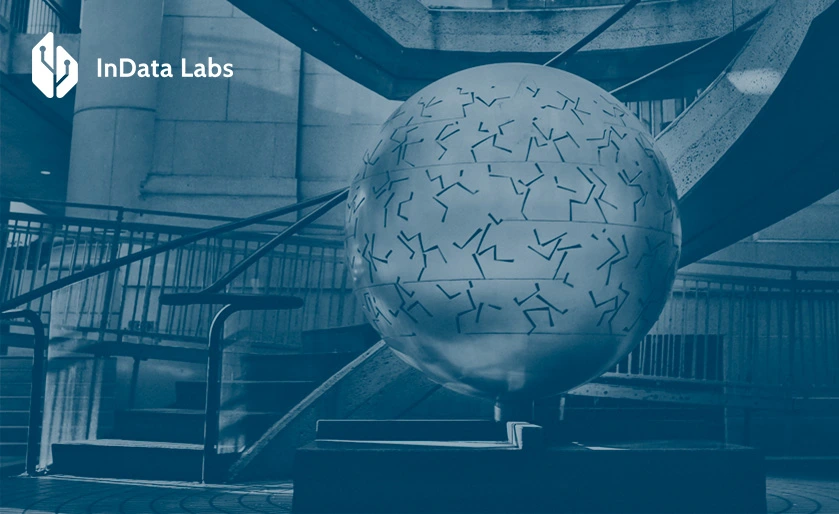The modern world is in the middle of a data revolution, where data will be the most important asset and currency for modern businesses. In 2024, the annual data generation will reach 147 zettabytes, and one needs Big data development assistance to manage, store, and process such vast amounts of data. This is why organizations worldwide seek to leverage Big data development to achieve their business goals.
The global Big data market will have a valuation of $650 billion by 2029. Also, the Analytics as a Service (AaaS) market size will become $69 billion by 2028. These two statistics prove businesses are leveraging Big data analytics on a large scale to gain a competitive advantage by mining meaningful insights from raw data.
Talking about global development and the world economy, Big data development services emerged as a powerful tool, enabling policymakers, governments, and social welfare NGOs to craft targeted schemes that positively impact people’s lives. From mapping the poverty index to analyzing the sex ratio to streamlining healthcare data, Big data technologies are at the forefront of these flagship schemes.

Source: Unsplash
In addition, global Big data solutions empower governments to achieve United Nations – Sustainable Development Goals (UN SDG). This blog post will explore how Big data makes a valuable impact on global development and the world economy. Before going into the technicalities of the subject, firstly, examine some basics of Big data solutions and how they work. Based on this foundation, understanding the Big data impact on society and global development will become easier.
What is Big data?
Big data consists of structured data, unstructured data, and semi-structured data collected by modern organizations. One can develop Big data applications to mine insightful information or use it for various Big data projects related to artificial intelligence, machine learning, predictive analytics, and other analytical techniques.
Any Big data has three significant characteristics, or 3Vs, as industry people refer to it. These 3 V’s are:
- Volume: The amount of data to be processed. It can be an unknown quantity, such as Twitter data feeds, clickstreams on a web page or a mobile app, etc. For some organizations, this data can be in terabytes; for others, it can be in petabytes.
- Velocity: The rate at which organizations receive data. Generally, the highest velocity of data goes into memory, and slower velocity data gets written on the disk.
- Variety: It refers to the type of data available. Generally, Big data comes in semistructured or unstructured form, and data sources are text, audio, and video.
Big data development is creating and managing large volumes of data where traditional data processing methods become incompetent. A Big data development company can collect, store, process, analyze, and interpret vast amounts of data to derive exciting insights for various organizations.

Lastly, many people ask if Big data is an AI. The answer is no. Big data and AI are two separate technologies.
However, one can use them together to drive business benefits. Any AI model requires vast datasets to make accurate predictions, and a Big data analytics development company can provide the raw material for AI. AI can help a Big data software development company uncover meaningful insights that drive business decisions.
Examples of Big data
Big data encompasses vast volumes of information collected from various sources, such as social media, sensors, and transaction records. Here are some Big data examples that are transforming organizations across various industries:
- Healthcare systems utilize patient data for predictive analytics, improving treatment outcomes.
- Transportation industries employ data from GPS devices and traffic sensors to optimize routes and reduce congestion.
- Financial institutions analyze market trends and customer transactions to detect fraud and manage risk effectively.
- Meteorologists use weather data from satellites and sensors to forecast conditions accurately. Government agencies analyze census data to make informed policy decisions.
- Researchers utilize genomic data for advancements in medicine and biology.
Benefits of Big data analytics
Small, medium, or large businesses can greatly benefit by harnessing the power of Big data analytics. Big data can empower businesses across various industries to uncover patterns, trends, and colorations among the data that can help them optimize their daily operations, enhance customer experiences, and drive innovation.

Source: Unsplash
This section explores the transformative power of Big data by diving deeper into some of the most common benefits of Big data analytics:
Customer acquisition and retention
Any consumer’s digital footprint tells many things about their preferences, needs, and purchasing patterns. Businesses can use Big data analytics to uncover these consumer behaviors and customize their products or services accordingly. It will help businesses to ensure customer satisfaction and drive customer loyalty. It will also help businesses to increase their customer retention.
Focused and targeted marketing
With the help of Big data analytics, businesses can know their ideal customers and their likes and dislikes. Based on these details, they can create a focused and targeted campaign with more chances of success rather than an anonymous campaign with wider audience targeting and less chance of success.
Potential risk identification
Predictive analytics is a massive part of Big data analytics and comes to the fore regarding risk identification. Businesses functioning in a high-risk environment can use Big data tools to predict future trends and analyze the possible risks to mitigate them before they become a point of failure.
Competitive analysis
To become a successful business person, one needs to know the strengths and weaknesses of their competitors. For this purpose, Big data analytics can help. It can provide insights into current market conditions, customer trends, what’s working and not working for competitors, and more. Based on this analysis, businesses can formulate strategies to stay ahead of the competition.
As discussed above, Big data analytics provides myriad benefits across various industries. It allows businesses to stay ahead and drive home the advantage in a highly competitive market. Lastly, Big data analytics allows businesses to achieve their goals and objectives precisely.
Types of Big data
Before going into the nitty-gritty of the Big data app development process, understanding the various types of Big data is essential. Here are the three major types of Big data:
- Structured data: It is well-defined and well-organized. Analyzing Big data of this type is more manageable for businesses as the information is well-structured. Any Big data business development company can easily store and access this data type. Examples are credit card number, phone number, address, age, etc.
- Unstructured data: It has no recognized structure, and its size is more extensive than structured data. There is no clear organizational structure or definition of this data. This data type is chaotic and challenging for any organization to handle and use. Examples are Google Search, Yahoo Search, Twitter News Feed, etc.
- Semi-structured data: It combines structured and unstructured data. Semi-structured data has some features of structured data, but the information here is unstructured, and therefore, it doesn’t fit within any data models or relational database systems. Examples are XML or JSON.
As far as businesses are concerned, they can use structured, unstructured, and semi-structured data for different purposes. Structured data with a pre-defined and fixed format can help businesses in decision-making processes such as inventory management and financial forecasting. On the other hand, businesses can use semi-structured data to derive valuable insights from sources like social media feeds or customer feedback forms, enhancing marketing strategies and customer engagement.
Lastly, unstructured data allows businesses to analyze sentiment and identify trends to identify customer preferences. By harnessing any of these Big data, businesses can streamline their business processes and stay ahead of their competitors.
How does Big data analytics work?
Here is a step-by-step guide to how a Big data analytics process works:
Step 1: Collect data
Firstly, organizations must collect the raw data on which the Big data analytics process will be performed. Now, the data collection process is different for every organization. Various technologies are available, such as cloud computing, IoT sensors, mobile applications, etc., through which organizations can collect the required data. These data can be structured or unstructured, and one can store them in data warehouses. The data that are complicated to handle or are very diverse can be stored in the data lake.

Source: Unsplash
Step 2: Process data
After collecting and storing the data in a data warehouse or data lake, companies need to organize them properly to drive accurate results based on analytical queries, especially while dealing with large and unstructured data formats. There are two options for processing these amounts of data: batch processing and stream processing.
Batch processing looks at large blocks of data and is a valuable method when there’s a vast turnaround time between the collection and processing of data. On the other hand, stream processing looks at small batches of data and is a helpful method when there’s a short turnaround time between the collection and processing of data.
Step 3: Clean data
After processing a lot of data, one must perform a cleanup process to improve the data quality. All data should have proper formatting, and any duplicate or irrelevant data should be removed. Any dirty data in the system can lead to inaccurate or flawed business insights.
Step 4: Analyze data
After completing the clean-up process, organizations can use advanced analytics processes to turn data into meaningful insights. Some of the famous Big data analytics methods are:

Importance of Big data in global development
In the last decade, there has been a massive data revolution. All these became possible due to the rise of the open-source data movement, the explosion of Big data analytics, and advancements in data science, machine learning, AI, and IoT. These advancements have paved the way for new-age, high-quality, more detailed, timely, and relevant information.
Every sector uses Big data analytics to its advantage, and the same applies to global development and the world economy. Big data analytics and the meaningful insights extracted through it can be a goldmine for policymakers and governments across the globe.
Let’s understand this with a prime example of the United Nation’s Sustainable Development Goals (SDG).
In 2015, the world decided to embrace new development goals known as SDG. These SDGs require actions on social, environmental, and economic challenges. But, for this purpose, the government needs hardcore data on their population and the data that represents their social and economic conditions. That’s where Big data can play an influential role. It can help national governments achieve each of the 17 goals.

Source: Unsplash
For example, here’s how Big data can help governments with some of the SDGs:
SDG 1: No Poverty – Here, Big data can collect mobile phone spending patterns, giving a fair idea of income levels.
SDG 2: Zero Hunger – Big data can track food prices online to analyze food security.
SDG 3: Good Health and Well-Being – Big data can map smartphone users’ movement to predict where infectious diseases can spread.
SDG 4: Quality Education – Tracking citizen reports through Big data can uncover the reason for student drop-outs, and solving them can lead to a better literacy rate.
SDG 5: Gender Equality – Analyzing men’s and women’s financial transactions and spending patterns can help analyze the gap.
SDG 6: Clean Water and Sanitation – Governments can connect intelligent sensors on water pumps to track water quality.
SDG 7: Affordable and Clean Energy – Smart metering can help governments analyze the current usage of electricity and their monthly patterns to ensure adequate supply.
Similarly, Big data analytics can be used for other goals as well. In addition to the UN SDG, Big data analytics is also helpful in driving international trade. By analyzing the current spending patterns of global consumers, businesses or nations can devise products, goods, and services that resonate at the international level, thereby boosting international trade.
Also, Big data can influence supply chain management for global business and trade as it can predict the future need for goods and services. Lastly, governments can use Big data analytics and BI tools to monitor and track the progress of their programs and flagship schemes to know whether they’re working well or if any changes are required.
Importance of Big data in business
Over the past few years, Big data has changed how businesses are conducted in the global marketplace. With the advent of Big data analytics, businesses have become more data-driven. They’re making more informed decisions rather than relying solely on their gut feeling. Also, with the rise of Big data analytics, businesses understand consumer behavior far better than previous generations, helping them increase their sales and revenue.
Here are some of the ways through which Big data can help in business growth:
Better business intelligence: With the help of Big data analytics, businesses can become more informed about consumer behavior. The reason behind this is Big data analytics’ better business intelligence capabilities. Big data can help businesses uncover new trends and patterns and identify consumer behavior, which helps them to make better decisions that were not possible with traditional information or raw datasets.
Proactive customer service: Big data analytics allows businesses to know the customers’ concerns even before they raise any issue. It will revolutionize businesses as customer service will get enhanced and more real-time, allowing customers to enjoy the benefits of service. Real-time customer service analyzes customer accounts and the kind of purchases he/she is making. Based on that analysis, customer service can address some of a customer’s pain points before they become a headache.

Source: Unsplash
Enhanced operational efficiency: Any business constantly looks for ways to enhance its efficiency. That’s where Big data analytics comes into the picture. It can identify patterns, trends, and correlations within vast datasets. Businesses can optimize inventory management, streamline supply chains, and enhance resource allocation by analyzing customer behavior, market trends, and internal processes.
Reduced business cost: Big data analytics can potentially reduce operational costs for various businesses. It can optimize operations, identify inefficiencies, and streamline processes. By analyzing large volumes of data, businesses can uncover patterns and trends that reveal areas for cost savings, such as reducing energy consumption, minimizing waste, and improving resource allocation.
Use cases of Big data analytics across industries
Here are the various use cases of Big data analytics across multiple industries:
- E-commerce: Big data analytics in E-commerce can help with inventory management, price optimization, product management, performance monitoring, etc.
- Banking and financial services: Fraud detection, asset management, insurance, etc.
- Agriculture: Precision farming, climate change prediction, equipment optimization, etc
- Manufacturing: Predictive maintenance, operational efficiency, production optimization, etc.
- Healthcare: Genomic research, personalized patient care, real-time alerting for critical situations, etc.
Challenges of Big data analytics (with possible solutions)
Here are the major Big data problems and solutions that organizations must be aware of:
Challenge 1: The unmanageable volume of Big data
Big data analytics involves processing gigabytes, terabytes, and sometimes petabytes of data. If these datasets are not handled properly, it can become a challenge for companies to drive meaningful information.
Solution: There is a need for adequate architecture, computing power, and infrastructure. That’s where cloud computing can be a helpful solution. Whether public, private, or hybrid, cloud computing solutions have high-end infrastructure, great scalability, and fantastic computing power to process Big data analytics. Also, by implementing cloud cost optimization techniques, one can leverage the best solutions at an affordable cost.

Source: Unsplash
Challenge 2: Poor data quality
Poor data quality is one of the biggest challenges of an organization when dealing with Big data analytics. Any poor-quality data can lead to errors, inefficiency, and misleading insights, which can add to the total cost of ownership for any business.
Solution: Organizations can establish adequate data governance policies. They can also use tools for data management and access control. Lastly, one can set up an effective process for cleansing, filtering, sorting, and enriching data with modern data analytics techniques.
Challenge 3: Dealing with multiple data formats
As you know, while dealing with Big data analytics, you may encounter various data formats, such as structured, unstructured, and semi-structured. So, the challenge for any organization is to combine all these into one format that aligns with the business needs.
Solution: One can use various modern data analytics tools and techniques that help to reformat unstructured data. If dealing with multiple data formats, one may have to employ a combination of different tools. The organization can also create custom applications that align with the business requirements and process multiple data formats the business is dealing with.
To wrap it up
Big data has the potential to transform global development efforts and improve lives around the world. By harnessing massive datasets, development organizations can gain powerful insights to tackle complex issues more effectively.
However, realizing the full potential of Big data in this domain requires addressing critical challenges like building analytical capacity, ensuring data privacy, and designing responsible AI systems. If one can manage those issues, Big data can become a vital tool for accelerating progress on the UN Sustainable Development Goals and creating a more just and equitable future for all.



